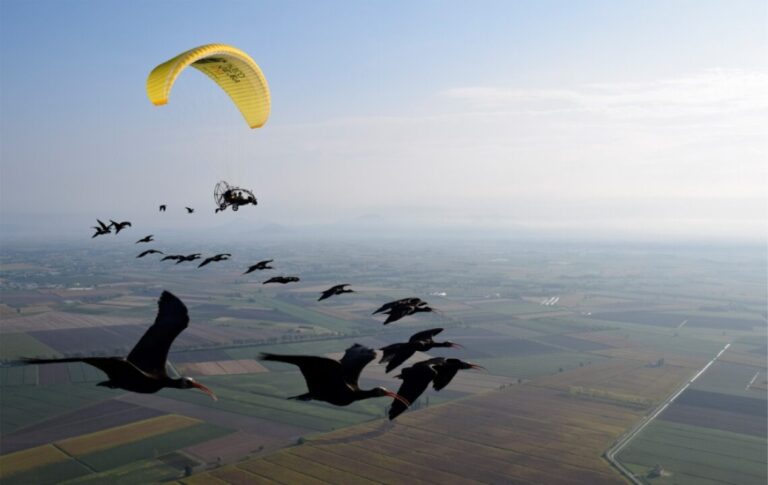![]()
An Austrian ornithologist has pioneered an innovative wildlife rehabilitation technique that involves nurturing chicks of an endangered species and reintroducing them to their natural migratory patterns using ultralight aircraft guidance.
The visionary method was developed to aid the reconnection of the northern bald ibis, a bird that disappeared from Europe 400 years ago, with its seasonal migration route from northern Europe to warmer southern regions.
The history of these ibises is rich and stretches back in time. By the era when the Pilgrims first set eyes on Plymouth Rock, European populations had almost entirely consumed these birds. Thankfully, separate colonies survived in West and East Africa, as well as in the Fertile Crescent.
In 2002, a dedicated team of scientists and conservationists embarked on a study to explore the feasibility of reintroducing the northern bald ibis to Europe. This promising research endeavor subsequently paved the way for a reintroduction initiative backed by the European LIFE-program in 2014.
Distinguished as the pioneering project to reintegrate a migratory species into the wild, it gained fame for its remarkable technique of human-assisted migration, featuring breathtaking images of the birds following ultralight aircraft.
Johannes Fritz, the head and founder of Waldrappteam Conservation and Research, explains, “The foundation for reintroduction is laid with northern bald ibis chicks from zoo breeding programs. These chicks are raised by human foster parents and trained to trail a microlight airplane, with human foster parents serving as co-pilots. This method steers the young birds to their wintering grounds in autumn, where they are then released.”
Johannes Fritz emerged as the driving force behind this endeavor, dedicating boundless effort to reestablish the birds’ natural migratory patterns. This 56-year-old biologist and pilot played a pivotal role in the reintroduction project and discovered that despite extended periods of captivity, the birds’ inherent migratory instincts remained intact. However, their journey “south” inadvertently led them to Russia.
This realization prompted him to guide them across the Alps using his ultralight aircraft, particularly at the end of September.
In 2011, a significant milestone was achieved when the first northern bald ibis autonomously migrated from its wintering region in Tuscany to its breeding grounds in Bavaria. This event marked the inception of a novel migratory tradition. Yet, this achievement was a long time in the making, and there remained a substantial distance to cover before these birds could migrate in substantial numbers without risk.
Unfortunately, the evolving climate introduced instability to their migration routes. Their instincts urged them to depart their breeding grounds north of the Alps in late October, but by November, the mountainous terrain became impassable due to harsh weather conditions involving wind and snow. Regrettably, three migration attempts were thwarted by these challenges.
Reference:








WOW!
This is mind blowing!